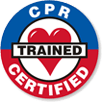3 of the Best CPR Practices
In practical terms, there is no difference between CPR (cardiopulmonary resuscitation) or BLS (basic life support). They are in fact, two terms for the same practice. That said, here are some easy ways to improve your CPR skills, some of the best practices as advised by the experts, such as the ACLS Certification Institute. Keeping the patient in the most optimal position possible is essential to keeping them alive until EMS services can arrive. In this blog, we’ll highlight three of the best CPR practices you can undertake. As always, safety is key.
Best CPR Practice #1: Patient Position
In order to achieve the best possible result, keep the patient flat on their backs on the nearest hard surface, even if it is the floor. Also keep the head in easy reach. Of course, this is sometimes unfeasible, especially if you don’t know what injuries the patient has; moving them might only serve to hurt them worse. Sometimes all you can do is rely on your best judgment and wait for support to arrive.
Best CPR Practice #2: Use a Backboard
Backboards are essential in keeping patients stable, particularly when it comes to possible head, neck, or spine injuries. Backboards can also serve as a hard surface to facilitate the next vital step in the CPR process, compressions. For compressions to work, your hands must be able to rapidly press down on the patient’s chest. The key thing is a solid surface to press against. Even in the heat of the immediate scene, getting a backboard if needed is supremely important.
Best CPR Practice #3: Placement of Care/Support Team
Lastly, the third of the three best practices once again has to do with positioning. Keep yourself and the patient clear of obstructions. Not only only is the position of the patient a vital consideration, but where the caregivers and support team are positioned is just as important. Be aware of nearby hazards and how safe it is to begin performing CPR. Consider how having multiple people around to help is important; of course you can help by yourself, but compressions can quickly get tiring. Rescue breathing, blowing air into the mouth or lungs of the patient, is another critical component of CPR. Two caregivers can quickly switch back and forth between giving compressions and giving rescue breaths.
Prioritizing Safety with G & M Services
G & M Services is proud of our employees and the dedication they have for safety in the workplace. Our employees are also rewarded for positive safety practices. We incorporate weekly and monthly discussions and meetings to ensure that all involved are aware of how to handle equipment and potential situations that could occur during a project.
G & M Services offers services in the way of concrete drilling and sawing, concrete scanning, and FireStop. To get started with G & M Services, call us today at 410-787-8828 or visit our contact page.
Follow the official G & M Services page today on Google+, Facebook, Twitter, and LinkedIn.









